i bc27f85be50b71b1 (229 page)
Read i bc27f85be50b71b1 Online
Authors: Unknown
Postoperative complications that may develop in the denervated
transplanted lung include pulmonary edema or effusion, acute respiratory distress syndrome, dehiscence of the bronchial anastomosis, and anastomotic stenosis.3 Single-lung transplant recipients may
experience complications of ventilation-perfusion mismatch and
hyperinflation owing to the markedly different respiratory mechanics
in each hemithorax.13 The rate of infection in lung transplant recipients is higher than that of other organ transplant recipients, because the graft is exposed to the external environment through the recipient's native airway. The patient's white blood cell (WBC) and absolute neutrophil count are monitored closely.6 Bacterial pneumonia and
bronchial infections are very common complications that usually
occur in the first 30 days.3,13 Bronchoalveolar lavage is used to diagnose opportunistic infections.17
Clinical manifestations of acute pulmonary rejection in lung transplant recipients include dyspnea, nonproductive cough, leukocytosis, hypoxemia, pulmonary infiltrates as seen on chest x-ray, sudden deterioration of pulmonary function tests (PITs), elevated WBC count, need for ventilatory support, fever, and fatigue.6.12,16 The rejection
typically presents with a sudden deterioration of clinical status over
6-12 hours'7 Daily documentation of the oxygen saturation and the
FEY I is used to monitor and detect early rejection, especially in bilateral lung transplant recipients, because a decline in oxygen saturation or spirometry values in excess of 10% commonly accompany episodes of rejection or infection.J,4,43
Bronchoscopic lung biopsy and bronchiolar lavages are used to diagnose acute rejection. The presence of perivascular lymphocytic infiltrates is the histologic hallmark of acute rejection.3.17 Transbronchial biopsies often do not supply enough pulmonary parenchyma for histologic testing." Instead, cyroimmunologic monitoring of the peripheral blood may be used as a specific diagnostic test for acute pulmonary
rejection. Bronchoscopy is performed routinely and whenever rejection


ORGAN TRANSI)LANTATION
731
is suspected to assess airway secretions, healing of the anastomosis, and
the condition of the bronchial mucous membrane." The first bronchoscopy is performed in the operating room to inspect the bronchial anastomosis.17 To prevent infection and atelectasis, rourine fiberoptic bronchoscopy with saline lavage and suctioning are used to reduce
accumulation of secretions that the recipient is unable to c1ear.1J
Clinical Tip
• If the recipient is intubated, sllctioning may be performed with a premeasured catheter ro prevent damage to
the anastomosis. Suctioning removes secretions and helps
maintain adequate oxygenation.
• After lung transplantation, recipients should sleep in
reverse Trendelenburg position to aid in postural drainage,
as long as they are hemodynamically stable.
• In the intensive care unit, during the first 24 hours after
surgery, patients with double-lung transplants should be
turned side to side. Turning is initiated gradually, beginning with 20- to 30-degree [Urns and assessing vital signs, and then increasing gradually to 90 degrees each way,
every 1-2 hours. Prolonged periods in supine position are
avoided to minimize secretion retention. 12
• Patients with single-lung transplants should lie on their
nonoperative side to reduce postsurgical edema, assist
with gravitational drainage of the airway, and promote
optimal inflation of the new lung.'2
• Bronchopulmonary hygiene before exercise may enhance
the recipient's activity tolerance.
• Schedule physical therapy visits after the patient
receives his or her nebulizer treatment and after the patient
is premedicated for pain control. Incisional pain can limit
activiry progression, deep breathing exercises, and coughing. Also, splinting the incision with the use of a pillow can help reduce incisional pain while coughing.
• Lung transplant recipients follow strict thoracotomy
precautions. They are nOt allowed to lift anything heavier
than 10 lb. They are restricred to partial weight bearing
of their upper extremities, which may limit the use of an
assistive device.

732
AClJTE CARE HANDBOOK FOR PHYSICAL THERAPISTS
• Patients are on respiratory isolation precautions; exercise is performed in the recipient's room. All staff muSt mask, gown, and glove on entering the patient's room for
approximately I week. However, the recipient may ambulate in the hallway, if a protective mask is worn.
• Always monitor the recipient's oxygen saturation
before, during, and afrer exercise. If the patient is on
room air at rest, supplemental oxygen may be beneficial
during exercise to reduce dyspnea and improve activity
tolerance. The lung transplant recipient should maintain
an arterial oxyhemoglobin saturation greater than 90%
with activity.41
• Multiple rest periods may be required during activity at
the beginning of the postoperative period to limit the
amount of dyspnea and muscle fatigue. Rest periods can be
gradually decreased so that the patient advances toward
periods of continuous exercise as endurance improves.
Heart-Lung Transplantation
Heart-lung transplantation is performed on patients who have a coexistence of end-stage pulmonary disease and advanced cardiac disease that produces right-sided heart failure.'2
Indications for HLT include the followingl·8•24:
• Primary pulmonary hypertension
• COPD
• Cystic fibrosis
• Pulmonary fibrosis
• Eisenmenger's syndrome
• Irreparable cardiac defects or congenital heart disease
• Advanced lung disease and coexisting left ventricular dysfunction or extensive coronary arrery disease
The heart and lung of the donor are removed en bloc and placed in
the recipient's chest. The anastomosis to join the donor organs is at


ORGAN TRANSI'LANTATION 733
the trachea, right atrium, and aorta.8•U Postoperative HLT care is
similar to the heart and lung post-transplant care previously discussed. Rejection of the heart and lung allografts occurs independent of each other.24 Bacterial pneumonia from contamination in the
donor tracheobronchial tree is the most common cause of morbidity
and mortaliry afrer HLT.8
Bone Marrow Transplantarion
BMTs are performed only afrer conventional merhods of trearmenr
fail to replace defecrive bone marrow. BMT recipients receive healthy
marrow from a living donor in an attempt to restore hematologic and
immunologic functions. The three rypes of BMTs are allogeneic, syngeneic, and autOlogous transplants.
I .
An allogeneic transplant is one in which bone marrow is
harvested from an HL A-matched donor and immediately infused
into the recipient after cytoreduction therapy. The donor may be
related or unrelated.
2.
A syngeneic transplant is one in which bone marrow is
harvested from an identical twin.
3.
An alltologolls transplallf is one in which the donor and
recipient are the same. Bone marrow is harvested from the patient
when he or she is healrhy or in complete remission. The marrow is
then frozen and stOred for future reinfusion.
One type of autologous BMT is rhe peripheral blood srem cell
(PBSC) transplant. Stem cells are primirive cells found in bone marrow or circulating blood that evolve into mature blood cells (whire cells, red cells, and platelets). The parient's PBSCs are harvesred by
leukapheresis. During leukapheresis, the patient's blood is circulated
through a high-speed cell separator in which the peripheral srem
cells are frozen and srored, and the plasma cells and eryrhrocyres are
reinfused into the patient. The patient may require three to seven
harvests to achieve an adequate number of srem cells.' The PBSCs
are rein fused after rhe parient receives lethal doses of chemotherapy,
radiation, or borh. Allogenic PBSC transplant may be performed
from a donor or by using umbilical cord blood from a newborn
The hematologic recovery afrer PBSC rransplant is 10-12 days,
